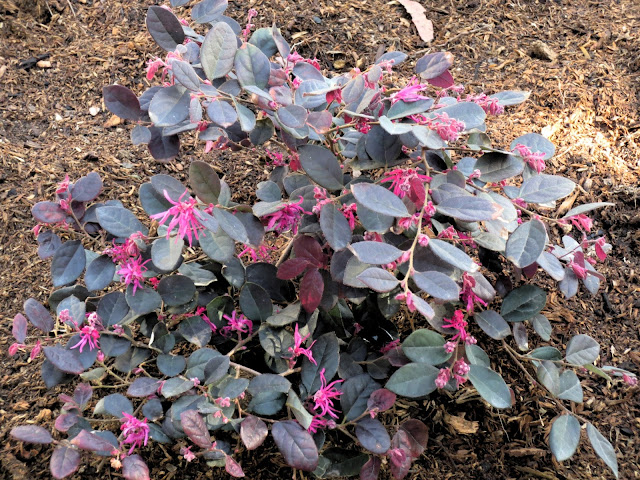What I was left with is an irregularly-shaped bed close to 20 feet long. It's approximately 9 feet across at its widest point, narrowing to 3 feet at the far end. It slopes slightly on one side, where it is bounded by a stacked manufactured stone wall. A dirt pathway, now covered with Eucalyptus sawdust, runs along its side, leading to another planting area facing the street. The bed gets full sun part of the day but, even with the large tree's removal, it's shaded for portions of the day by other trees nearby.
The only plant left alive in the bed after the Eucalyptus was removed was a scraggly Osteospermum (variety unknown). I pulled out much of the Eucalyptus sawdust left behind by the tree service crew and worked in bags and bags of compost, as well as a basic fertilizer. I considered leaving the bed alone for awhile but, with our living room overlooking the space, I couldn't face that much bare earth day after day.
I didn't want to put another tree in as there are already 2 California Pepper trees (Schinus molle), 2 Strawberry trees (Abutus 'Marina'), a tree-size Toyon (Heteromeles arbutifolia), and a variety of tall hedges in the immediate area. I considered several shrubs and was semi-settled on using Pittosporum tenufolium 'Marjorie Channon' as my centerpiece plant; however, even after checking the plant out at a local nursery, I was having a hard time getting excited about the choice. I nonetheless took my working plant list along when 2 friends and I took a trip to Rogers Garden, an Orange County nursery, last week.
Rogers had a large selection of Pittosporum tenufolium varieties but I fell in love with another shrub across the aisle: Dryms lanceolata, commonly known as the Mountain Pepper. This variety was a new selection, part of Monrovia's "Dan Hinkley Collection." I liked the dark green leaves and red stems. The shrub is supposed to produce aromatic greenish flowers in spring, followed by black berries in fall. It grows 10-15 feet tall and 10 feet wide, although I can't find any reference to its speed of growth. It's reported to like partial sun. The only downside is that it requires regular water.
 |
| Dryms lanceolata |
Of course, changing my featured shrub required changes to the rest of my plant list as well. I decided to try a purple-leaved Loropetalum (Loropetalum chinense var. rubrum 'Hine's Plum Leaf'). I was lucky to find 3 of these in good condition in 3 quart pots at Lowes so I saved some money there. These plants can grow 6-8 feet tall by 8 feet wide but I've been told their size can be managed with regular pruning.
 |
| Loropetalum chinense var. rubrum 'Hine's Plum Leaf' |
I picked up a few accent plants while at Rogers (it was an expensive visit), including 3 Heuchera maxima and 3 Coprosma 'Plum Hussy'.
 |
| Heuchera maxima |
 |
| Coprosma 'Plum Hussey' |
I was also tempted by a few annuals I wanted to trial. Rogers offered selections produced by by favorite mail-order nursery, Annie's Annuals & Perennials, without the shipping charge.
 |
| Anagellis monellii 'Blue Pimpernel' |
 |
| Nigella hispanica 'African Bride" with Argyrantemum 'Elsa White' and Alyssum |
I also spruced up the adjoining bed with a selection of succulents and more annuals.
 |
| Crassula radicans, Graptosedum 'California Sunset', and Sedum 'Salsa Verde' |
 |
| Nemophila menziesii 'Baby Blue Eyes' |
Despite these efforts, the bed still looks very bare!
 |
| After initial planting |
 |
| Another view after planting |
I need to add edging plants and, as the Mountain Pepper and Chinese Fringe Flowers will take time to fill out, I'll probably fill in with some additional annuals and/or short-lived perennials. Here's what I'm considering:
- Plectranthus - cuttings from existing plant, noID, possibly Plectranthus fruticosus
- Nicotiana langsdorfffii (green flowered tobacco)
- Heuchera - purple leaved variety
- Ajuga reptans 'Catlin's Giant' (Bugle weed)
- Teucrium chamaedrys (Germander)
- Seslaria caerulea (Blue Moor Grass)
- Dichondra argentea 'Silver Falls'
- Stachys byzantina (Lamb's Ears)
- Athyrium niponicum pictum 'Silver Falls' (Japanese Painted Fern)
- Clematis terniflora (Sweet Autumn Clematis) - to climb arbor
Price and availability will factor into final selections but that's my current working list. What else would you add?


One way I filled my planting beds last summer was with annual vines, specifically melons, although this year I'll try some different ones. I just let the crawl all over the ground, and the look lush and green. Your new bed looks awesome, and yay for saving money on the plants!
ReplyDeleteI've yet to be successful with melons here, Renee, but maybe I'll try them again. Thanks for stopping by!
DeleteNew beds always look a little bare, but I love your selections - especially the dryms and the coprosma. I don't know these plants, but they are beautiful. How fun to have a new area to plant - good luck with the rest of your selections.
ReplyDeleteThe Dryms is new to me so I have my fingers crossed it will do well (especially as I made it my feature plant in this bed). I have another 'Plum Hussy' Coprosma and it has done well here. Now I just need to find more plants to complement these choices...
DeleteI LOOOVE your Graptosedum 'California Sunset.' Great choice! Looks like it will be a really lovely space.
ReplyDeleteI'm quite pleased with 'California Sunset' too, Louis. Even better - I found these succulents in an inexpensive 6-pack! More nurseries in my area are offering succulents this way, which makes it a lot easier to experiment with new plants.
Delete